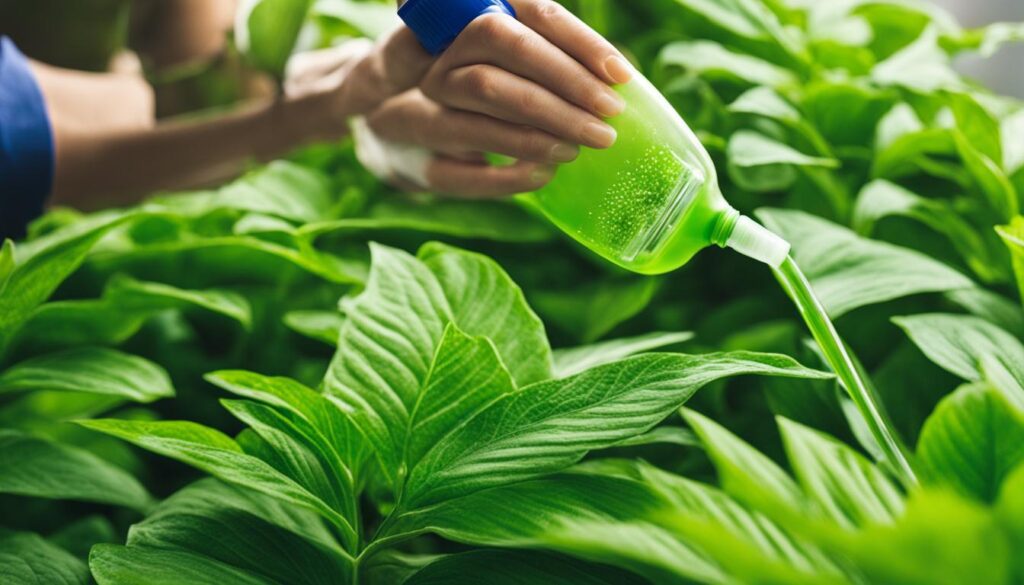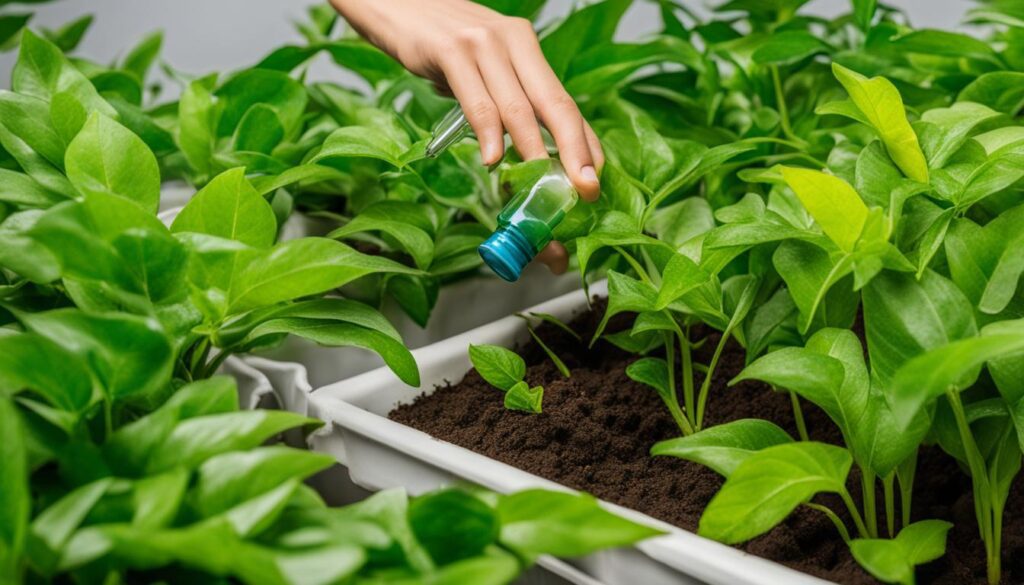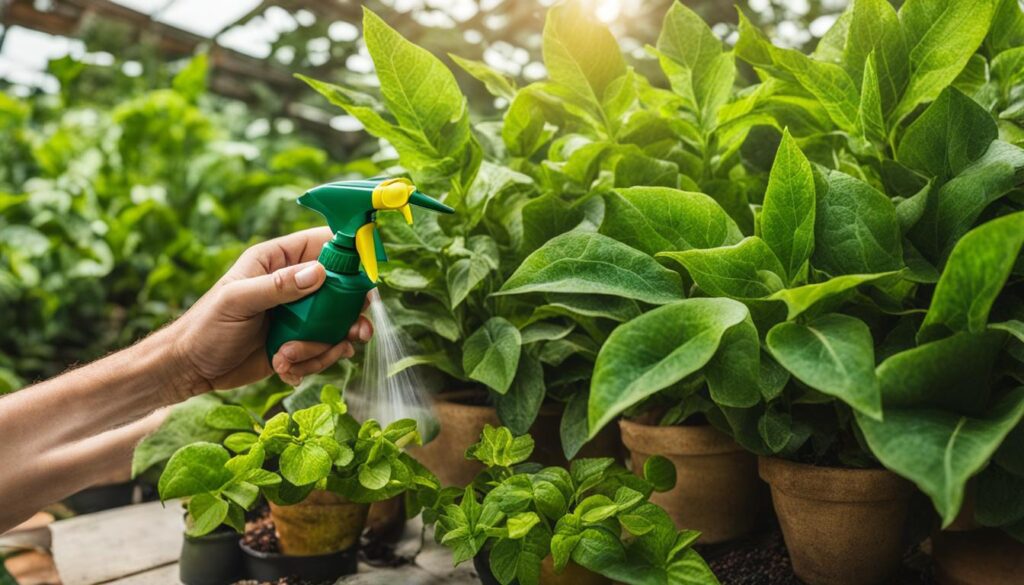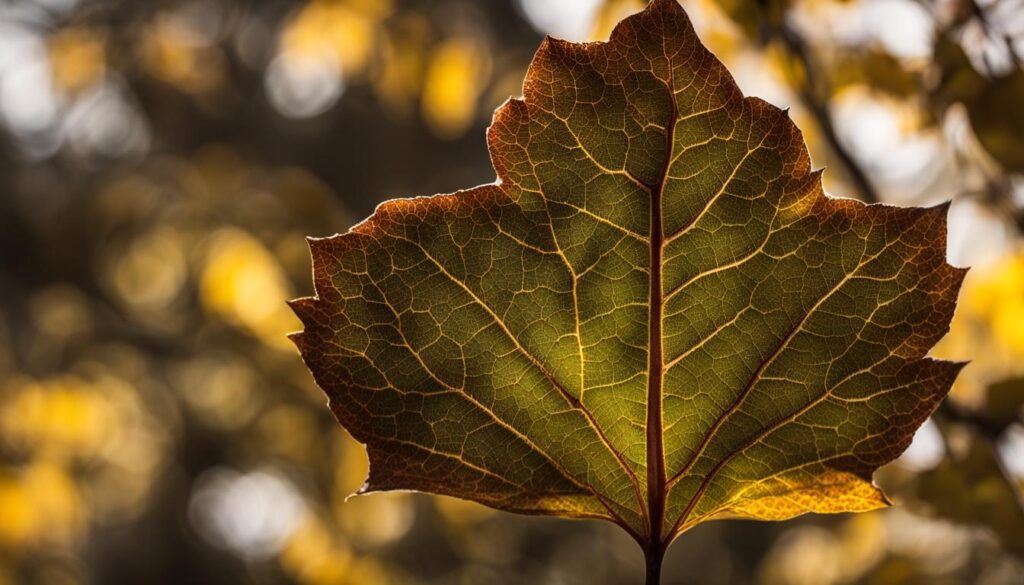Chlorosis is a common problem that can impact the health and vitality of plants, causing their leaves to turn yellow due to a lack of chlorophyll. Several factors, such as nutrient deficiencies and alkaline soil, can contribute to chlorosis. However, the good news is that there are effective treatments available to restore the lush green color to your plants and improve their overall well-being.
Key Takeaways:
- Chlorosis is a condition where plants develop yellow leaves due to a lack of chlorophyll.
- The main cause of iron chlorosis, a common type of chlorosis, is either an iron deficiency in the soil or soils that are too alkaline.
- Symptoms of iron chlorosis include yellowing leaves with green veins, stunted growth, and a lack of flowering or fruiting.
- Effective treatments for iron chlorosis include improving the soil, adjusting the pH, and using appropriate amendments.
- Prevention and long-term solutions for iron chlorosis involve selecting tolerant plant species and improving the rooting environment.
Understanding Iron Chlorosis in Plants
Iron chlorosis is a common type of chlorosis that occurs when plants are unable to absorb sufficient iron from the soil, leading to the lack of chlorophyll production. This condition primarily affects certain tree and shrub species, including white pine, white oak, pin oak, tulip tree, magnolia, sweet gum, bald cypress, dogwood, birch, cherry, and apple.
The main cause of iron chlorosis is either an iron deficiency in the soil or soils that are too alkaline, preventing iron absorption. When plants lack sufficient iron, they are unable to produce chlorophyll, resulting in yellowing leaves and overall poor growth. This can significantly impact the health and appearance of affected plants.
A soil test is an essential diagnostic tool for identifying iron chlorosis. It can determine the iron levels in the soil and help guide the appropriate treatment. Additionally, understanding the specific tree or shrub species that are prone to iron chlorosis is crucial for effective management and prevention.
Note: The image above provides a visual representation of plants affected by chlorosis, highlighting the importance of effective treatments for iron deficiency in plants.
Symptoms and Diagnosis of Iron Chlorosis
The first sign of iron chlorosis is yellowing leaves, which typically appear on new growth first. A key characteristic of iron chlorosis is that the veins on the yellow leaves remain green. In severe cases, the yellow leaves may turn white and drop, twigs and branches may be stunted or die, and the plant may fail to flower or fruit. It’s important to distinguish iron chlorosis from other causes of yellowing leaves, such as disease, insects, or lack of water. Conducting a soil test can confirm the presence of iron deficiency and help diagnose iron chlorosis.
Treating Iron Chlorosis in Plants
When it comes to treating iron chlorosis in plants, there are several effective methods that can help restore the health and vibrancy of your greenery. It all starts with improving the soil conditions to provide essential nutrients and promote long-term recovery.
To begin, consider adding organic compost and bark mulch to the soil. These amendments not only enrich the soil with valuable nutrients but also enhance its structure, allowing for better water and nutrient retention.
Adjusting the soil pH is another crucial step in treating iron chlorosis, especially if the soil is too alkaline. You can do this by adding sulfur or other acidifying amendments to create a more favorable pH balance.
If your soil test reveals a deficiency of iron or other essential minerals like manganese, it’s essential to use appropriate amendments to correct the problem. These amendments are specifically formulated to replenish the nutrient levels in the soil, helping the plants overcome their chlorosis symptoms.
Additionally, a foliar spray with an iron compound can provide temporary relief by supplying the plants with much-needed iron. However, it’s important to note that this treatment alone is not sufficient for lasting results. Amending the soil with the necessary nutrients is vital for sustainable growth and improved plant health.
Prevention and Control of Iron Chlorosis
Preventing and controlling iron chlorosis is crucial for maintaining the health and vitality of your plants. By implementing the following measures, you can effectively manage chlorosis and ensure the lush green appearance of your garden.
Plant Selection
When planning your garden, opt for tree and shrub species that are less susceptible to chlorosis. Research and choose plants that are known to tolerate high pH soils and are less likely to experience iron deficiency. This proactive approach can significantly reduce the risk of chlorosis in your landscape.
Soil Improvement
Creating a favorable soil environment is key to preventing chlorosis. Avoid planting chlorosis-prone species in high pH or alkaline soils and those with low organic matter content. Regularly amend the soil with compost and organic matter to improve nutrient availability and enhance the overall health of your plants.
Proper Plant Culture
Establishing proper plant culture practices can go a long way in preventing chlorosis. Avoid overwatering or creating waterlogged conditions, as excessive moisture can hinder nutrient uptake. Additionally, ensure good soil drainage to prevent water from pooling around the roots, which can contribute to chlorosis.
Fertilizer Management
When applying fertilizers, be mindful of their composition and the specific nutrient needs of your plants. Limit the use of fertilizers that are high in potassium, magnesium, and phosphorus, as excessive amounts of these nutrients can contribute to chlorosis. Instead, opt for balanced fertilizers that provide essential micronutrients like iron.
Regular Watering
During dry periods, it’s important to provide adequate water to your plants. Drought stress can exacerbate chlorosis symptoms and weaken the overall health of your plants. Regularly monitor soil moisture levels and water deeply and infrequently to ensure your plants are adequately hydrated.
By implementing these preventive measures, you can effectively control and manage iron chlorosis in your plants. With a proactive approach and proper care, you can enjoy a vibrant and healthy garden year-round.
Long-Term Solutions for Iron Chlorosis
To achieve long-term chlorosis treatment success, I recommend focusing on improving the rooting environment of the affected trees. By creating an optimal environment for root growth and nutrient uptake, you can help prevent and manage iron chlorosis effectively.
Start by removing any grass or competing vegetation from around the base of the tree. This will reduce competition for nutrients and allow the tree’s roots to access the essential elements they need. Additionally, it’s essential to apply a layer of organic compost and mulch around the tree. This will not only provide valuable nutrients but also help retain moisture and regulate soil temperature, creating a favorable rooting environment.
Proper watering is crucial for minimizing stress and ensuring the tree’s health. Irrigate regularly to keep the soil moist but not waterlogged. A well-hydrated tree will be better equipped to absorb essential nutrients, including iron, from the soil.
When it comes to fertilization, it’s important to avoid using potassium and phosphorus unless a deficiency is indicated by a soil test. Excessive amounts of these nutrients can exacerbate iron chlorosis. Instead, focus on applying sulfur to the soil. Sulfur helps lower the soil pH, creating a more acidic environment that enhances iron availability to the tree’s roots.
By implementing these long-term solutions, you can create an ideal rooting environment for your trees, ultimately improving their ability to uptake nutrients and effectively manage chlorosis. The image below illustrates the importance of a healthy rooting environment:
Remember, treating iron chlorosis requires a multi-pronged approach, combining short-term treatments with long-term solutions. In the next section, I will explore short-term solutions that provide immediate relief for iron chlorosis but require ongoing management.
Short-Term Solutions for Iron Chlorosis
When it comes to treating iron chlorosis, short-term solutions can provide immediate relief while you work on long-term treatments. These temporary fixes can help bring back the green vibrancy to your plants and address the underlying iron deficiency.
One effective short-term solution for iron chlorosis is soil fertilization with nitrogen or sulfur-based fertilizers. These fertilizers not only provide the necessary acidity to improve nutrient availability but also help in greening up the affected plants.
Another option is incorporating chelated iron into the soil. Chelated iron is a form of iron that is readily available for plants to absorb and utilize. This can help replenish the iron levels in the soil and promote healthy chlorophyll production.
Additionally, applying foliar sprays of iron or manganese sulfate can provide quick relief for iron chlorosis. Foliar sprays are applied directly to the leaves and can be absorbed by the plant to address the immediate nutrient deficiency. However, it’s important to note that foliar sprays only correct the leaves that are treated, and repeated applications may be necessary for lasting results.
For larger trees, trunk injections can be an effective short-term solution. Trunk injections involve injecting iron or other essential nutrients directly into the tree trunk, allowing for long-lasting relief from iron chlorosis.
Remember, while short-term solutions can provide quick relief, they should be supplemented with long-term treatments to achieve lasting results. By combining short-term and long-term approaches, you can effectively manage iron chlorosis and restore the health and beauty of your plants.


Additional Considerations for Iron Chlorosis Treatment
When treating iron chlorosis, it is important to take into consideration the specific needs and tolerance of different plant species. Some plants exhibit greater tolerance to high pH soils and are less likely to be affected by low iron availability. To ensure successful treatment, it is crucial to select the appropriate plant species and cultivars that are well-suited for the soil conditions in your garden.
Avoid planting highly susceptible selections in areas with high soil pH, as recurring chlorosis can weaken the plants and make them more susceptible to other problems. Instead, opt for plant species that have demonstrated resilience and adaptability to alkaline soil conditions. By choosing the right plants for your garden, you can minimize the risk of iron chlorosis and promote healthier growth.
If you are unsure about the best treatment options for your specific situation, it is advisable to consult with a local gardening expert or professional arborist. These knowledgeable professionals can provide valuable insights and guidance tailored to your garden’s unique needs. Their expertise will help you make informed decisions and develop an effective treatment plan to address chlorosis and maintain the vitality of your plants.
By considering plant species tolerance and seeking expert advice, you can implement a comprehensive approach to treating iron chlorosis. Understanding the specific needs of your plants and the characteristics of your soil will empower you to make informed decisions and take appropriate actions. With proper treatment and care, your garden will flourish with vibrant, healthy plants, free from the constraints of chlorosis.
Expert Advice for Iron Chlorosis Treatment
If you need professional advice or have lingering questions about treating iron chlorosis, I recommend seeking assistance from experts. Visit your local garden center and consult with the knowledgeable staff who can provide guidance on the best treatment options for your garden. They are well-equipped to help you determine the proper soil amendments, fertilizers, and foliar sprays based on your specific situation and the needs of your plants. Additionally, professional arborists can offer their expertise in trunk injections and long-term management of iron chlorosis in larger trees.


Expert advice is invaluable to ensure you are taking the right steps in effectively treating iron chlorosis. These professionals can provide personalized recommendations and assistance tailored to your garden’s unique conditions. Whether you need immediate solutions or long-term management strategies, seeking professional advice will give you the confidence to revitalize your plants and maintain a healthy, vibrant garden.
Conclusion
Chlorosis, particularly iron chlorosis, is a common problem that affects the health and appearance of plants. It occurs when plants lack chlorophyll production due to iron deficiency in the soil or alkaline soil conditions. However, there are effective treatments available to manage chlorosis and restore the vibrant green color to your plants.
To address chlorosis, it is important to diagnose the specific cause and implement the appropriate treatments. Short-term solutions such as soil fertilization with nitrogen or sulfur-based fertilizers and foliar sprays can provide immediate relief. Additionally, long-term solutions such as improving the tree’s rooting environment by removing grass, applying organic compost and mulch, and adjusting the soil pH can promote lasting recovery.
When dealing with chlorosis, it is advisable to consult with gardening experts and professionals who can provide personalized advice and assistance tailored to your specific situation. By following the recommended treatments and maintaining proper plant culture, you can revitalize your garden and enjoy the beauty of healthy, vibrant plants. Take action now and say goodbye to chlorosis.
FAQ
What is chlorosis?
Chlorosis is a condition where plants develop yellow leaves due to a lack of chlorophyll.
What causes iron chlorosis?
Iron chlorosis is primarily caused by an iron deficiency in the soil or soils that are too alkaline.
How can I diagnose iron chlorosis?
Conducting a soil test can help diagnose iron chlorosis by confirming the presence of iron deficiency.
What are the symptoms of iron chlorosis?
The first sign of iron chlorosis is yellowing leaves, with green veins. Severe cases may lead to leaf drop and stunted growth.
How can I treat iron chlorosis in plants?
Treating iron chlorosis involves improving the soil, adjusting the pH, and using appropriate amendments to correct iron deficiency.
How can I prevent and control iron chlorosis?
Prevention and control can be achieved through proper plant selection, soil management, and limiting the use of certain fertilizers.
Are there long-term solutions for iron chlorosis?
Yes, improving the tree’s rooting environment by removing grass, applying organic compost and mulch, and adjusting the pH can provide long-term relief.
Are there short-term solutions for iron chlorosis?
Yes, short-term solutions include soil fertilization and foliar sprays to provide immediate relief, although they may require repeated applications.
What should I consider when treating iron chlorosis?
Consider the tolerance and needs of different plant species, as well as the soil conditions present in your garden.
Where can I get expert advice on iron chlorosis treatment?
Consult with a local gardening expert or professional arborist at your nearest garden center for personalized guidance.



